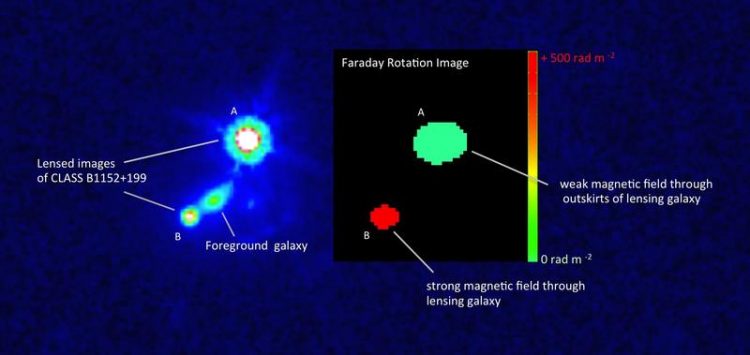The detection of magnetic fields in a galaxy 5 billion light years away

Left: HST image of CLASS B1152+199. The background quasar is lensed by the foreground galaxy into two images A and B. Right: Faraday rotation of the lensed images. Sui Ann Mao, with HST image from the Hubble Legacy Archive (Rusin et al. 2002, MNRAS, 330, 205-211).
Using observations of a gigantic cosmic lens carried out with the Karl G. Jansky Very Large Array, a team of astronomers has detected coherent magnetic fields in a galaxy as seen almost five billion light years away. These measurements provide new clues about a problem at the frontiers of cosmology: the nature and origin of the magnetic fields that play an important role in the evolution of galaxies.
When a background quasar and a foreground distant galaxy are closely aligned along the line of sight as in the system CLASS B1152+199, light from the quasar is gravitationally lensed by the foreground galaxy, forming two separate images as seen from Earth. One can use the light from the quasar passing through different parts of the lensing galaxy to study magnetic fields in a galaxy we otherwise cannot see.
The team measured a property of the radio waves called polarization that changes when passing through the magnetic field of the foreground galaxy. The astronomers measured this change, the so-called Faraday rotation effect, of the two lensed quasar images to show that the distant lensing galaxy hosts a coherent large-scale magnetic field.
The detection of a strong coherent magnetic field in a galaxy when the universe was about two-thirds of its current age allows the team to measure how fast these fields grow in galaxies. “Although this distant galaxy had less time to build up its magnetic field compared to local galaxies, it still managed to do so”, says Sui Ann Mao, leader of a Minerva research group at the Max Planck Institute for Radio Astronomy in Bonn, the lead author of the study. “The results of our study support the idea that galaxy magnetic fields are generated by a dynamo process.” she adds.
Despite great progress in cosmology, how the Universe became magnetized remains an unsolved problem. It is generally recognized that the original magnetic fields in no way resemble the fields we see today in galaxies, but have been amplified and reconfigured by dynamo processes tied to circulation and turbulence within the interstellar gas. Describing the dynamo, particularly how it imparts large-scale structures to the magnetic field, is itself a largely unsolved problem. “Our measurements have provided the most stringent test to-date of how dynamos operate in galaxies”, says Ellen Zweibel from the University of Wisconsin Madison, USA.
“This finding is exciting – it is the first time we can reliably derive both the magnetic field strength and its configuration in a distant galaxy,” says Sui Ann Mao. The strong lensing system CLASS B1152+199 is now the record holder of the highest redshift galaxy for which this magnetic field information is available. “Our work demonstrates the power of strong gravitational lensing and broadband radio polarimetric observations in revealing magnetic fields in the high redshift universe,” she concludes.
The National Radio Astronomy Observatory is a facility of the National Science Foundation operated under cooperative agreement by Associated Universities, Inc.
The Hubble Legacy Archive is a collaboration between the Space Telescope Science Institute (STScI/NASA), the Space Telescope European Coordinating Facility (ST-ECF/ESA) and the Canadian Astronomy Data Centre (CADC/NRC/CSA).
The research team consists of Sui Ann Mao, the leading author, moreover Chris Carilli, Bryan M. Gaensler, Olaf Wucknitz, Charles Keeton, Aritra Basu, Rainer Beck, Philipp P. Kronberg and Ellen Zweibel.
Sui Ann Mao is the leader of the Minerva research group on Cosmic Magnetism at the Max Planck Institute for Radio Astronomy.
Original Paper:
Detection of microgauss coherent magnetic fields in a galaxy five billion years ago, S. A. Mao et al., 2017, Nature Astronomy Advanced Online Publication (August 28, 2017). DOI: 10.1038/s41550-017-0218
http://dx.doi.org/10.1038/s41550-017-0218 (after the embargo expires)
Contact:
Dr. Sui Ann Mao,
Leader of Minerva Research Group “Cosmic Magnetism”
Max-Planck-Institut für Radioastronomie, Bonn.
Fon: +49 228 525-246
E-mail: mao@mpifr-bonn.mpg.de
Dr. Rainer Beck
Max-Planck-Institut für Radioastronomie, Bonn.
Fon: +49 228 525 323
E-mail: rbeck@mpifr-bonn.mpg.de
Dr. Olaf Wucknitz
Max-Planck-Institut für Radioastronomie, Bonn.
Fon: +49 228 525 481
E-mail: wucknitz@mpifr-bonn.mpg.de
Dr. Norbert Junkes,
Press and Public Outreach
Max-Planck-Institut für Radioastronomie, Bonn.
Fon: +49 228 525-399
E-mail: njunkes@mpifr-bonn.mpg.de
Media Contact
All latest news from the category: Physics and Astronomy
This area deals with the fundamental laws and building blocks of nature and how they interact, the properties and the behavior of matter, and research into space and time and their structures.
innovations-report provides in-depth reports and articles on subjects such as astrophysics, laser technologies, nuclear, quantum, particle and solid-state physics, nanotechnologies, planetary research and findings (Mars, Venus) and developments related to the Hubble Telescope.
Newest articles

Silicon Carbide Innovation Alliance to drive industrial-scale semiconductor work
Known for its ability to withstand extreme environments and high voltages, silicon carbide (SiC) is a semiconducting material made up of silicon and carbon atoms arranged into crystals that is…

New SPECT/CT technique shows impressive biomarker identification
…offers increased access for prostate cancer patients. A novel SPECT/CT acquisition method can accurately detect radiopharmaceutical biodistribution in a convenient manner for prostate cancer patients, opening the door for more…

How 3D printers can give robots a soft touch
Soft skin coverings and touch sensors have emerged as a promising feature for robots that are both safer and more intuitive for human interaction, but they are expensive and difficult…





















